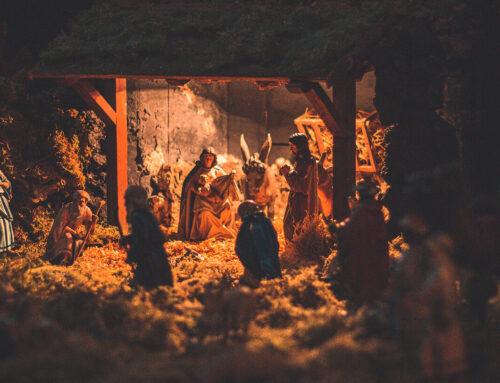Christmas holds a special place in my heart, not because of any religion or theological beliefs, but mostly because it was my dad’s favorite holiday and because it’s a time of year for many family traditions and rituals to be played out. Every year we know the traditional frustration of hanging lights on the house will happen. We have come to depend on the stories we tell while pulling 50 years of homemade ornaments out of boxes, each one weirder than the next as we recall who made it and when.
I know we will cry as we look at the ones my late brother made a couple months before his death. And of course, we will NOT allow my mother to “cull the herd” of ornaments when she announces yet again, that there are too many and not enough room on the tree. We will wear out our muscles as we roll out dough for 1,200 raviolis, a 300-year old tradition in my family. And of course we will mathematically and analytically decide which cookies to make, since we certainly can’t make all the recipes.
As “surface” as some of these stories may be, they are older than anyone in my family—they have roots that go far back into history. The same is true for Christmas. It is more than December 25, something that happened in a manger 2,000 years ago, or a holiday celebrated by almost a third of the world’s population. So what do I want to say about it? What’s the piece of truth in the Christmas myth (and yes, it is a myth), and is there a gift Christmas still brings me?
To answer these questions, I need to put the holiday within the context of its own roots and tradition to seek out the patterns of Christmas that are still emerging within the human story. As I said, the Christmas story is a myth. So if you are feeling tension as you read these words, just breathe and stick with me, because for the next four weeks, we will be on a journey exploring this beloved story in a new light, seeing the word become flesh every day, not just December 25.
Our Collective Stories
Let me first explain about a myth. They are traditional stories told in every culture, oftentimes with a historical basis lost over time, and they generally explain the origins of man. Myths are our collective story of what our lives mean, and we need this meaning to thrive. Jean Houston, scholar, author and founder in the “human potentials movement” says, “Myths are more than old tales; they are ‘codes and roads and maps.’ Where we wind up on life’s journey depends on the map we carry with us.”
Myths emerged at a very early date, they are as old as Neanderthal man, and are a result of inventing stories that go beyond the everyday life experience. Myths generally are born out of a vivid imagination, and while they aren’t really rational, they are imbued with a deeper meaning that gives value to life. Interestingly, myths are inextricably entwined with ritual and ceremony, and what greater ritual do we have than the ritual of Christmas?
Myths have gotten a bad rap over the years, relegated to the position of being called fables or fake, or at times redlined as useless. They are anything but! What makes them so powerful, so enduring, is that they speak to something greater and unknown. Our myths point to another world that lives parallel to our human experience. They bring to life archetypes, which are collectively inherited ancient old, unconscious ideas, patterns of thought and images that resonate deeply within the human family. When we tap into these archetypes, these universal truths unhindered by time, culture, and space, we are taking the mystery of our stories, which have no words, and bringing them into manifest form. We bring the invisible world into reality.
More important, myths support and inform what I believe and how I behave, they are my road map. A myth is the mirror unto my everyday life; it is the perfect pattern of the infinite potential and possibility for living fully human and fully divine. Keep this in mind as I unravel the myth of Christmas over the next several weeks, because this myth really has little to do with theology and everything to do with what it means to be human.
The Beginnings
So let’s take a look at the beginnings of our Christmas story, our beloved myth. The Bible stories of the first Christmas are both personal and political. The nativity narratives speak to the personal and political transformation of the writers and of the times in which they were written. Yet their roots are deep, going back centuries before they were ever written.
Various pagan myths were alive long before Jesus and each had a savior born from mating between a god and a virgin, at the winter solstice, the darkest and coldest time of the year, who then performs some miracles, has a communal meal, and is sacrificed at the spring equinox, finally returning after spending a little time in the netherworld. Sound familiar? This would have been the archetypal energy that the writers of Jesus’ birth stories would have been immersed in and probably even familiar with.
The birth narratives show up in the Gospel of Matthew and the Gospel of Luke. For the first-century writers of these Gospels in a Roman world, these stories were subversive. Jesus, not Herod, was the real “king of the Jews.” Jesus, not Caesar, was the son of God, savior of the world, the one who brings peace on earth. In Roman imperial theology, Caesar had all these titles. Jesus, rather than the emperor, who was said to be the son of Apollo, the god of light, was the real light of the world.
Here are some of the highlights from the Gospel of Matthew:
- Mary neither speaks nor gets any revelation and Joseph is the main character.
- Herod is a main character, with supporting roles by the wise men, and he drives the plot.
- Alarmed at the prospect of a rival king, Herod tells the wise men to bring him word so he can pay homage to the newborn king, whom he really plans to kill.
- The wise men follow the star to a house (not a stable) and in a dream are told not to return to Herod.
- Joseph is told in a dream to escape to Egypt, and stays there until Herod’s death.
- Then the story jumps forward 30 years, John the Baptist preaching in the wilderness and the mature Jesus going to be with him.
Here are some of the highlights from the Gospel of Luke:
- Luke’s nativity story is four times as long, doesn’t include a genealogy (the first chapter of Matthew is entirely a genealogy).
- Much is about the parents of John the Baptist, Zechariah, and Elizabeth, who aren’t even mentioned by Matthew.
- Women play much more prominent role, including Mary as the central character and Joseph is almost invisible.
- It includes lots of music, a chorus of angels, three hymns, each sung like an aria.
- The most familiar parts of the story: Caesar’s decree of census, the journey to Bethlehem, the birth of Jesus in a stable, and angels proclaiming the birth to shepherds.
- Luke’s story extends into Jesus’ infancy and youth. It mentions his circumcision and presentation in the temple at 40 days, then tells of his amazing the temple teachers with his wisdom at age 12.
- For the earliest Christians whether or not these stories were factual wasn’t relevant, people focused on their meaning. A myth isn’t about accuracy or facts; it is about the truth embedded in the story that lingers for centuries and even millennia. A myth represents our own stories and beliefs, our curiosity and our yearnings to understand the world. In the end, a myth links us to our ancestors as well as to our present, to each other right here and now.
Knowing this story has been told in so many different ways, in so many places, we have come to understand and recognize there is some truth in it. Yet we must let go of our mythical beliefs; we have to lose what we have known, what we have been holding onto in order to gain it back, in order to re-embrace it for today’s world, in ever-increasing authentic ways.
How we understand the stories of Jesus’ birth matters. Both gospels tell very different stories, yet each holds great emotional power. Every retelling of the birth narrative, from the gospels, to the Christmas carols, to “A Charlie Brown Christmas,” touches the deepest yearnings of our hearts, beyond the bounds of theology, facts or history.
This myth longs to reflect the light in our darkest days, inviting us to create a different kind of world where our humanity fully expresses our divinity that is not just BORN in each one of us, but IS each one of us. In the next three weeks we’ll take a look at the deeper meaning of this universal Christmas story in order to truly engage in making our word flesh with each other.







